During a second stop at a favorite photo site where a stream flows from a large open lake to a large wetland, a pair of Western Grebes caught my attention when a downy hatchling popped its head out from beneath the feathers on the back of one of the adults! They were close, and as I focused on the adult grebe, another downy head popped into view, as did another hatchling on the back of the second adult of the pair. In an instant, 3 newly hatched Western Grebes revealed themselves, which turned into the beginning of 2 rewarding photo sessions!
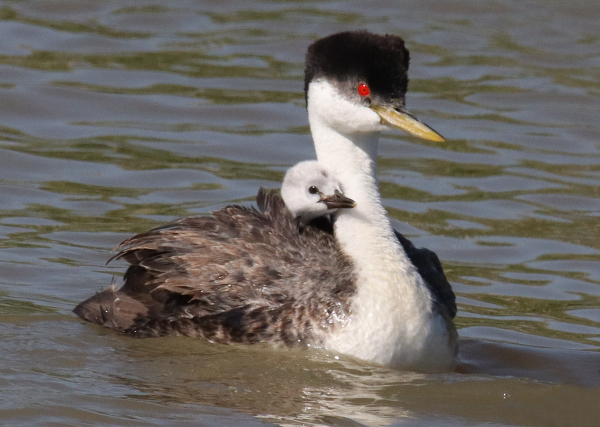
With previous experience photographing Western Grebes with recently hatched young riding their backs, I spent some time trying for a few special photographs that would record the intimacy among the pair and their dependent young. Realistically, that’s a big wish; first, you need to be close enough and stay close enough to get quality photographs, and in my case it was a matter of the grebes staying close to me. My position was pretty fixed, but a few grebes and several White Pelicans were “fishing” an open area of the stream between the 2 water bodies, the pair with 3 new hatchlings among them.
Second, it was not easy to photograph the downies on the backs of the adults as they slipped back inside the cover of the long back feathers on the adults. Then too, there were the usual movements to contend with as the adults swam this way and that and turned their head back and forth, all in quick movements. It took a lot of attention through the lens, focusing and refocusing, waiting for the right moment, anticipating, and making the most of photo opportunities. And that’s all the fun part, the part that makes your heart beat a little faster, that increases your senses and feeds your interest in taking some quality photos of interesting birds during exciting moments in their reproduction period.
Photographing was fast-paced as I watched for more than one downy hatchling to raise their head out of the cover of feathers while the adult moved its head this way and that, watching for its mate, other grebes and overtly large pelicans, as well as potential food. Hoping for 2 or 3 hatchlings to be alert with their heads raised out of the back feathers, and their faces showing in full sunlight, synchronized with the adult turning into the sunlight, it was surprising to see how rarely that happened.
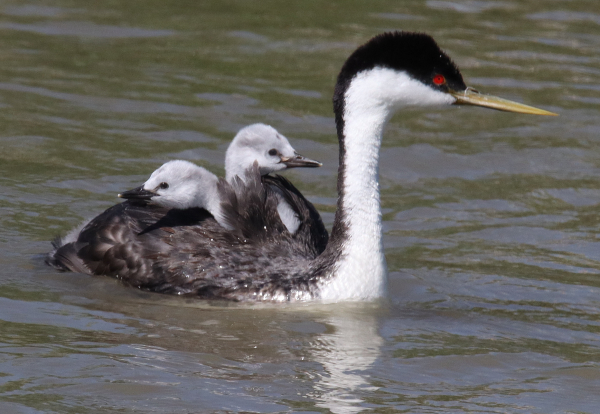
You might think that you see the birds and take a few photos, and move on; but that definitely was not the case, and that’s what made this photo session more of a challenge and all the more enjoyable, holding my attention for about an hour. Sure, you can manage a few initial photos, but that’s when the fun begins; and it’s when the effort becomes a bit more focused, but while you need to be aware, if not alert moment to moment, there was a fair amount of waiting for the birds to be in position and for the hatchlings to emerge from their feathered resting place. In the process, it was quite surprising to see how the downy hatchlings could hide so well beneath the feathers on the back of an adult – 2 could easily go unnoticed.
Of course, I timed everything so the sunlight illuminated the birds during the late afternoon, and I positioned my mobile blind with the sun at my back and the birds in front of me. Anticipating the need for a wide area in focus to keep more than one adult in focus at times, along with the downy hatchlings, I used an f-10 aperture, which worked well for that purpose. With an ISO setting of 800, the f-10 aperture also provided a corresponding fast shutter speed, usually faster than 1/1000 of a second to stop action and provide sharp images.
Eventually, 2 other pairs of Western Grebes approached the more open area of the stream, but they seemed to be put off by the much larger pelicans that numbered 13 at that point. One of the pairs included an adult with 4 downy hatchlings riding on its back – good thing she didn’t have 5 (ha). Usually among Western Grebes, the hatchlings will be moved to one adult’s back while the “free” adult forages and brings food back to the downy grebes. To reposition the hatchlings, an adult rises up and shakes its body or even flaps its wings in the process, shaking the young grebes into the water. They can swim well soon after hatching, and seem to know that they should switch over to the other adult’s back, climbing aboard from the tail forward.
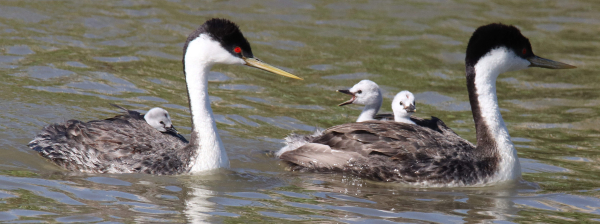
Having taken a bundle of photographs with the hope of getting a few choice images, there was a considerable review process ahead that night. After returning home in the dark, I took an initial look at the photos on my computer, and was pleased to see a few that stood out. The next step was editing the best of the best, which simply meant cropping each image to create the most pleasing image overall that included the birds and surrounding water.
The photos clearly showed the fine lighting at the time, and I tried to emphasize the positioning of the downy grebes in each image to show their cuteness, their frailty, their innocence, their hunger, and their attachment to the adults. Sometimes we overlook the importance of the photo review and editing process, but it’s an enjoyable part of photography, and it is essential for improving photos taken in the field. Even so, I try to limit my photo editing to simple cropping – cutting extraneous background and foreground areas, but often leaving a bit of extra space in front of the birds’ view rather than centering a bird in the frame.
A Second Photo Session; Learning More
Wednesday’s photo session was exhilarating, and it made me want to return the next sunny late afternoon, but each day it seemed clouds formed or blew in during that time frame. Finally, with a big storm headed in from the west about 6pm Saturday, I took a chance and drove back to Long Lake Refuge to see if I could get a second photo session with the grebes. Arriving at 4:30, it certainly wasn’t a given that grebes with young would be on hand, or within reach of my zoom lens. As I pulled up to the stream, a few single Western Grebes were fishing, but there were no pairs with young (darn); but there were other options close by.
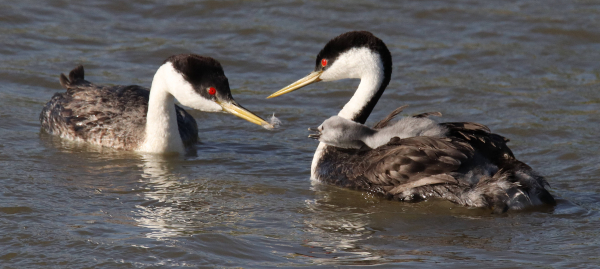
It turned out that in the adjoining marsh 5 pairs with downy young were present, but these grebes were not as trusting, staying beyond the range of my camera lens. I gave it a try though, but none of the resulting photos were sharp enough to edit. It was just a few hundred yards back to the inlet stream, and danged if there wasn’t a pair with little downies on their backs! It actually seemed as if it was the same grebe family, and judging from their behavior, I’m convinced it was.
I was a little more relaxed as I photographed Saturday afternoon, watching the approaching cumulous cloud bank in the west, but concentrating on the grebes before me. It was a little shorter photo session, but similar to before and I managed about an equal number of “keeper” photos, this time using an f-11 aperture. It was nice to see more new Western Grebe families active in the area, with many more pairs that would hatch downy young in coming days and weeks.
Photographing birds always seems to teach me more about the species before me. When I see something while photographing or notice things in the photos that I don’t see in the field, I always want to check references about given questions that arise – and I learn in the process. Of course, that’s been going on with me for decades, but it’s another part of birding that isn’t mentioned enough. For example, some of the new things I learned or that were underlined when I read about them included the facts that among Western Grebes:
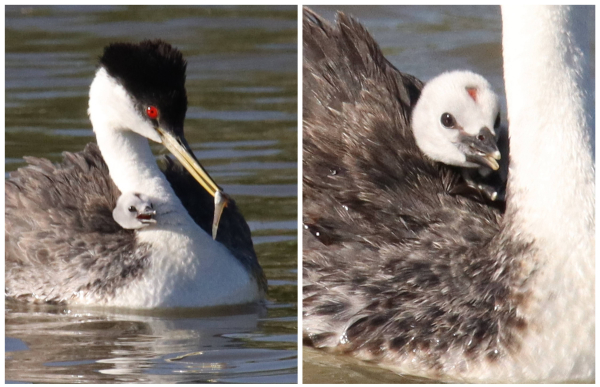
- Newly hatched young climb onto one of the adult’s back within minutes of hatching, a term described as “back-brooding.” The term is especially worthy when you consider that after hatching the precocial hatchlings cannot regulate their own body temperature, so rely on a brooding adult to provide a uniform warmth – provided from its back rather than from the traditional breast method of brooding when positioned on a nest or another substrate.
- Both adults brood hatchlings, although the male tends to carry newly-hatched young more frequently than the female. An adult with young on its back will rise up and flap its wings to discharge the young into the water at frequent intervals, which usually stimulates the hatchlings to defecate immediately, with downy young climbing onto the back of the same or other adult. (You never see white wash on the back of the adults.)
- The non-brooding adult brings food for young grebes, that may be fed directly, or the food may be passed to the other adult to feed the hatchlings on its back. The young Westies beg and emerge from beneath the adult’s back feathers with the promise of being fed; that’s also when a bare area of skin on the crown of a hatchling’s head flushes from straw-yellow to red in color. The red color apparently is a cue for the adults to feed that hatchling. Western Grebes occasionally feed their feathers to their young, beginning soon after they hatch. Overall, the young grebes are fed by the adults for about 2 months.
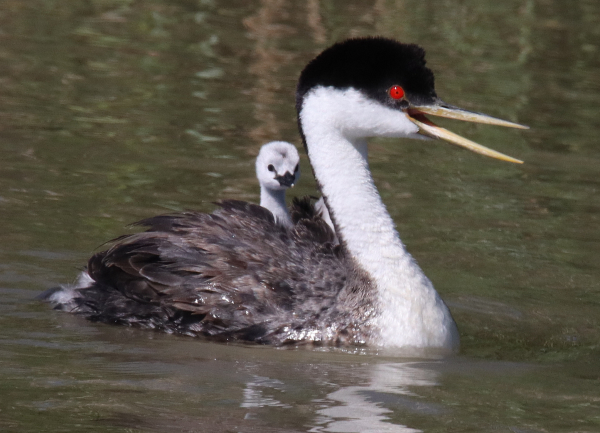
- When about 4 weeks old, the hatchlings’ belly feathers begin growing, which coincides with them spending less time on an adult’s back, but they still ride on an adult’s back occasionally even when 1/2 to 2/3 grown. Young Western Grebes begin diving and feeding themselves at several weeks of age, gradually increasing their independence until they are fully fledged and feed themselves. They are able to make short flights when their flight feathers are fully developed, approximately 70 days after hatching.
The above information answered a number of questions that came to mind while photographing the Western Grebes and while editing photos, and it helped me to understand the development of Western Grebes as part of their family group. (The above info was gleaned from a small portion of the information provided in the species description of Western Grebes on the Birds of the World website.)
If you have a chance to observe or even photograph Western Grebes this summer, enjoy the process. But it needn’t be Western Grebes in the focus of your camera lens – any birds will do, as I’m sure you are well aware of. It’s a beautiful time of the year to be in search of the next bird photo or photo series. Pursue it and appreciate it with a stimulated sense of discovery!
Article and Photographs by Paul Konrad
Share your bird photos and birding experiences at editorstbw2@gmail.com